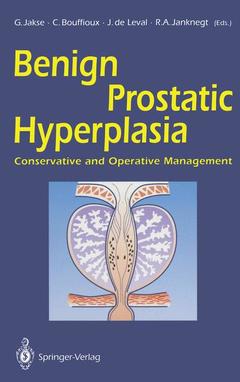Description
Benign Prostatic Hyperplasia, Softcover reprint of the original 1st ed. 1992
Conservative and Operative Management
Coordinators: Jakse Gerhard, Bouffioux Christian, Leval Jean de, Janknegt Rudi A.
Language: English
Subjects for Benign Prostatic Hyperplasia:
Keywords
Prostataerkrankung; Prostatahyperplasie; Urologie; benign prostatic hyperplasia (BPH); bladder outlet obstruction; endocrinology; erectile dysfunction; mortality; operative; nonoperative and meddical treatment; prostate; prostatectomy; transurethral balloon dilatation; transurethral resection (TURP); treatment; urology
Publication date: 10-2013
198 p. · 15.5x23.5 cm · Paperback
198 p. · 15.5x23.5 cm · Paperback
Description
/li>Contents
/li>
An intense discussion has recently begun regarding current standards in the diagnosis and treatment of benign prosta tic hyperplasia (BPH). A number of factors have led to this discussion. In an increasing proportion of aging men, for example, BPH causes so-called obstructive symptoms that must be relieved by medical or operative means. This entails an immense social and economic impact in terms of health costs. In addition, recent data indicate the most frequently performed operation for BPH - transurethral resection of the prostate - is associated with a higher risk of death due to cardiac disease than open prostatectomy. Furthermore, studies using the recently developed technique of uro dynamics to assess bladder outflow obstruction reveal that about 20% -30% of patients treated with transurethral resection or open prostatectomy are actually not obstructed. This means that these patients do not receive the most effective therapy. Finally, various new treatment been developed, including medical treat modalities have ment directed at endocrine pathways in the prostatic cells, balloon dilatation, spirals, temporary or permanent stents, C). nd the application of heat in hyperthermia or thermo therapy. The contributions to this volume were selected from a symposium on the diagnosis and treatment of BPH. They are intended to provide a comprehensive review of the state of the art in treating BPH. Aachen, Liege, Maastricht, September 1992 The Editors Contents Development of Benign Prostatic Hyperplasia 1 J. E. Altwein and H. Baur Bladder Outflow Obstruction: Definition, Clinical Application, and Grading in Benign Prostatic Hyperplasia. . . . . . .
Development of Benign Prostatic Hyperplasia.- Bladder Outflow Obstruction: Definition, Clinical Application, and Grading in Benign Prostatic Hyperplasia.- Operative Treatment.- When Should Open Prostatectomy Be Performed?.- Retropubic Transcervical Prostatectomy Without Catheter as a Modification of the Millin Technique..- Video-Guided Transurethral Resection: Raising the Gold Standard.- Transurethral Resection of the Prostate in Benign Prostatic Hyperplasia.- TURP Syndrome: Monitoring of Immunologic Parameters and Breath-Ethanol Content During Transurethral Prostatic Resection.- Urodynamic Assessment in Patients Undergoing Transurethral Resection of the Prostate: A Prospective Study.- Erectile Dysfunction After Transurethral Prostatectomy.- Nonoperative Treatment.- Are Metallic Endourological Stents an Alternative to Prostatectomy in the Management of Benign Prostatic Hyperplasia?.- Balloon Dilatation of the Prostate.- Urodynamic Studies Before and After Transurethral Balloon Dilatation of the Prostate.- Hyperthermia or Thermotherapy of Benign Prostatic Hyperplasia: What is the Difference?.- Transrectal Hyperthermia in Benign Prostatic Hyperplasia.- Transurethral Microwave Thermotherapy of the Prostate: Principles and Early Clinical Results.- Medical Treatment.- Is Pharmacotherapy for Benign Prostatic Hyperplasia an Alternative?.- Some Thoughts on the Mitogenesis of Benign Prostatic Hyperplasia.- Endocrinology of Normal and Pathological Development of the Prostate.- New Forms of Hormonal Treatment in Benign Prostatic Hyperplasia: Efficacy of Flutamide.- The Need for Objective Evaluation of Therapy in Benign Prostatic Hyperplasia.- Transurethrale Microwave Thermotherapy (TUMT) in Patients with Benign Prostatic Hyperplasia (BPH).
© 2024 LAVOISIER S.A.S.
These books may interest you

Male LUTS/BPH Made Easy 52.74 €



